Knowledge and Practice Regarding Hazards of Ultraviolet Radiation amongst Medical Students of Pakistan: A Cross-Sectional Study
Article Information
Samun Shahzad1, Faria Latif Sami1, Ali Ishtiaq1, Naveen Siddique Sheikh2,*, Mehsim Abid3, Hasban Ahmed4, Hania Latif Sami5, Nasir Anis5, Muhammad Usama Rafiq2
1Allama Iqbal Medical College, Lahore, Pakistan
2CMH-Lahore Medical College And Institute Of Dentistry, Lahore, Pakistan
3Lancashire Teaching Hospitals, NHS Trust, Preston, United Kingdom
4King Edward Medical University, Lahore, Pakistan
5Shalamar Medical and Dental College, Lahore, Pakistan
*Corresponding Author: Dr Naveen Siddique Sheikh, MBBS, CMH-Lahore Medical College and Institute of Dentistry, Lahore, Pakistan
Received: 25 September 2020; Accepted: 01 October 2020; Published: 13 October 2020
Citation: Samun Shahzad, Faria Latif Sami, Ali Ishtiaq, Naveen Siddique Sheikh, Mehsim Abid, Hasban Ahmed, Hania Latif Sami, Nasir Anis, Muhammad Usama Rafiq. Knowledge and Practice Regarding Hazards of Ultraviolet Radiation amongst Medical Students of Pakistan: A Cross-Sectional Study. Journal of Environmental Science and Public Health 4 (2020): 318-329.
View / Download Pdf Share at FacebookAbstract
Background: Ultraviolet radiation is a type of electromagnetic radiation whose origin is sun and man-made sources. Unprotected exposure to UV radiation has been attributed to causing diseases such as skin cancer, hence proper protection is necessary when coming in contact with a UV radiation source.
Objectives: To establish the knowledge and practices regarding the hazards of UV radiation exposure amongst undergraduate medical students.
Methodology: We conducted a cross-sectional study to determine the knowledge and practice regarding the hazards of UV radiation amongst medical students. Questionnaire was filled with a 100% response rate. Final data were analyzed with the help of SPSS version 21.0 and the descriptive statistics e.g. percentage and frequencies were calculated.
Results: Of the 200 participants, 69% were females and 31% were males. Regarding the effects of sun, level of knowledge averaged at 8.39 ± 1.71 out of 12 points. Of the participants, 27.5% had good general knowledge about the hazards of UV exposure and photoprotective practices, 69.5% had fair knowledge while 3% had poor knowledge on the subject matter. Umbrella was a popular choice for photoprotection amongst females with 57.2% reporting of its use while in male hat usage was the popular choice as reported by 14.5% of them. 35.5% of the participants reported never having received formal education about the hazards of UV radiation.
Conclusion: In Pakistan, medical students demonstrated good knowledge regarding the hazards of ultraviolet radiation but there was low usage of active sun-safe practices such as sunscreen which demonstrates that there is a gap between knowledge and practice.
Keywords
UV radiation; Knowledge; Practice; Hazards; Medical students
UV radiation articles, Knowledge articles; Practice articles; Hazards articles; Medical students articles
UV radiation articles UV radiation Research articles UV radiation review articles UV radiation PubMed articles UV radiation PubMed Central articles UV radiation 2023 articles UV radiation 2024 articles UV radiation Scopus articles UV radiation impact factor journals UV radiation Scopus journals UV radiation PubMed journals UV radiation medical journals UV radiation free journals UV radiation best journals UV radiation top journals UV radiation free medical journals UV radiation famous journals UV radiation Google Scholar indexed journals Practice articles Practice Research articles Practice review articles Practice PubMed articles Practice PubMed Central articles Practice 2023 articles Practice 2024 articles Practice Scopus articles Practice impact factor journals Practice Scopus journals Practice PubMed journals Practice medical journals Practice free journals Practice best journals Practice top journals Practice free medical journals Practice famous journals Practice Google Scholar indexed journals Hazards articles Hazards Research articles Hazards review articles Hazards PubMed articles Hazards PubMed Central articles Hazards 2023 articles Hazards 2024 articles Hazards Scopus articles Hazards impact factor journals Hazards Scopus journals Hazards PubMed journals Hazards medical journals Hazards free journals Hazards best journals Hazards top journals Hazards free medical journals Hazards famous journals Hazards Google Scholar indexed journals electromagnetic radiation articles electromagnetic radiation Research articles electromagnetic radiation review articles electromagnetic radiation PubMed articles electromagnetic radiation PubMed Central articles electromagnetic radiation 2023 articles electromagnetic radiation 2024 articles electromagnetic radiation Scopus articles electromagnetic radiation impact factor journals electromagnetic radiation Scopus journals electromagnetic radiation PubMed journals electromagnetic radiation medical journals electromagnetic radiation free journals electromagnetic radiation best journals electromagnetic radiation top journals electromagnetic radiation free medical journals electromagnetic radiation famous journals electromagnetic radiation Google Scholar indexed journals ozone layer articles ozone layer Research articles ozone layer review articles ozone layer PubMed articles ozone layer PubMed Central articles ozone layer 2023 articles ozone layer 2024 articles ozone layer Scopus articles ozone layer impact factor journals ozone layer Scopus journals ozone layer PubMed journals ozone layer medical journals ozone layer free journals ozone layer best journals ozone layer top journals ozone layer free medical journals ozone layer famous journals ozone layer Google Scholar indexed journals NCD articles NCD Research articles NCD review articles NCD PubMed articles NCD PubMed Central articles NCD 2023 articles NCD 2024 articles NCD Scopus articles NCD impact factor journals NCD Scopus journals NCD PubMed journals NCD medical journals NCD free journals NCD best journals NCD top journals NCD free medical journals NCD famous journals NCD Google Scholar indexed journals energy levels articles energy levels Research articles energy levels review articles energy levels PubMed articles energy levels PubMed Central articles energy levels 2023 articles energy levels 2024 articles energy levels Scopus articles energy levels impact factor journals energy levels Scopus journals energy levels PubMed journals energy levels medical journals energy levels free journals energy levels best journals energy levels top journals energy levels free medical journals energy levels famous journals energy levels Google Scholar indexed journals humans articles humans Research articles humans review articles humans PubMed articles humans PubMed Central articles humans 2023 articles humans 2024 articles humans Scopus articles humans impact factor journals humans Scopus journals humans PubMed journals humans medical journals humans free journals humans best journals humans top journals humans free medical journals humans famous journals humans Google Scholar indexed journals harmful effects articles harmful effects Research articles harmful effects review articles harmful effects PubMed articles harmful effects PubMed Central articles harmful effects 2023 articles harmful effects 2024 articles harmful effects Scopus articles harmful effects impact factor journals harmful effects Scopus journals harmful effects PubMed journals harmful effects medical journals harmful effects free journals harmful effects best journals harmful effects top journals harmful effects free medical journals harmful effects famous journals harmful effects Google Scholar indexed journals
Article Details
1. Introduction
Ultraviolet radiation is a type of electromagnetic radiation whose origin is sun and man-made sources such as welding torches and tanning beds. One of its classification is based on energy levels according to which it is subdivided into 3 types: UVA, UVB, and UVC [1]. UVA having the least energy level and UVC having the highest level of the three. The higher the energy levels, the more it is capable of causing damage. Thinning of the stratospheric ozone layer is responsible for exposing people to large quantities of ultraviolet radiation from the sun [2]. Other sources include the usage of indoor tanning beds as well as other appliances and devices that emit ultraviolet radiation [3, 4].
Various diseases have been attributed to unprotected sun exposure. Acute skin damage is manifested as tanning and sunburn while long term consequences of cumulative exposure include premature skin ageing, skin cancer(especially in fair-skinned persons), and damage to the eyes(cataracts) as well as immunosuppression [5-7]. Skin cancer in later life is associated with exposure to the sun in early life [8].
According to WHO, worldwide non-melanoma skin cancers amounting to 2-3 million cases and malignant melanoma skin cancer cases amounting to 132000 are diagnosed every year and in the USA development of skin cancer at some point in life is present in 1 in every 5 people [9]. One UK study also revealed that 86% of melanomas are attributed to exposure to sun exposure [10]. Use of effective photoprotective measures can prevent 80% of skin cancer cases. Despite this, there is an increase in skin cancer incidence [11]. Furthermore, ultraviolet radiation is attributed to incur a loss of 1.5 million days from people’s lives every year worldwide [12].
According to previous studies female, young and student responders were more likely to be aware of the connection between sun exposure and cancer [13]. But regarding sun-protective behaviours; body image, media, peers, and childhood habits appeared as key motivators [14]. Therefore, counselling parents about the hazards of the sun is of high yield [15, 16]. On the other hand, upon investigating the level of awareness regarding the effects of sun amongst students, the most well-known benefit identified by the responders was the synthesis of vitamin D [17].
Exposure of humans to the solar ultraviolet radiation has been identified to have important public health implications, also linked to one out of five people developing skin cancer at some point in life due to unprotected exposure to UV [18, 19]. In light of far-reaching harmful effects of exposure to UV radiation, this research was conducted to investigate the knowledge of undergraduate medical students about hazards of UV radiation exposure and the photoprotective practices adopted by them towards the exposure.
2. Methodology
A cross-sectional study was conducted at a public medical college in Lahore to determine the knowledge and practice of medical students towards the hazards of UV radiation exposure. The study was conducted in 2019. It included 200 participants, from the 4th year of the medical college. Non-probability/purposive sampling technique was adopted to enrol participants in the study. Research synopsis was approved by the Institutional Ethical Review Board. A questionnaire comprising of 18 questions was designed and filled by the participants after informed written consent. The questionnaire employed in data collection was formulated after a search of relevant literature and comprised of six questions regarding the socio-demographic variables of each student and 12 questions exploring the student’s knowledge regarding the effects of UV radiation from the sun and the student’s photoprotective practices. During data collection, in-person interviews were conducted to fill the questionnaires. Subjects were briefed about study purpose and methodology of research and were invited to ask questions. Participants were assured confidentiality of their personal information. The response rate by the participants was 100%. Data were analyzed by using SPSS (software package for statistical analysis) version 21.0 and descriptive statistics i.e frequency and percentages were obtained.
3. Results
The students who participated in the survey were aged between 19-23, with a mean age of 21 ± 2 years. 87% of the students who participated in this study were ≤22 years of age while 13% were above 22 years of age. Out of the 200 participants, 138 (69%) were female while 62 (31%) were male. Of the sampled students’ parents’ education level, 3% had only attained primary education, 15% had secondary while 81.5% of the students’ parents’ had graduated from university. As far as the participants’ socioeconomic status was concerned, 52.5% belonged to families with monthly income below Rs. 50,000 while the remainder of the 47.5% belonged to families with monthly income above Rs.50,000 i.e good socioeconomic status.
Overall, 94 students had a fair skin tone, 92 had wheatish complexion and only a small number of students (14) had a dark skin tone. Upon analyzing the residential status of individuals 56.5% were found to be boarders and 43.5% were day scholars. All demographic variables were analyzed but only the significant variable found in our study was skin tone (p<0.05). Students with wheatish complexion scored better than students with fair/dark skin tones with a mean score of 8.71±1.47. The other variables (age, gender, parental education, socioeconomic status, residential status) did not demonstrate any significant relation with the knowledge and practice score
(p> 0.05).
|
Variables |
N (%) |
Knowledge and Practice Score Mean ± (SD) |
P-value |
|
Age: ≤22 >22 |
174(87%) 26 (13%) |
8.35±1.71 8.65±1.69 |
0.603 |
|
Gender: Male Female |
62(31%) 138(69%) |
8.05±1.75 8.54±1.67 |
0.158 |
|
Parent’s Education Level: Primary: Secondary: University: |
68 (3%) 31 (15.5%) 163 (81.5%) |
9.33±1.51 8.42±1.57 |
0.196 |
|
Socioeconomic Status: Income above Rs.50,000 Income below Rs.50,000 |
95(47.5%) 105(52.5%) |
8.23±1.65 8.53±1.75 |
0.296 |
|
Skin Tone: Fair Wheatish Dark |
94(47%) 92(46%) 14(7%) |
8.21±1.77 8.71±1.47 7.50±2.28 |
0.000 |
|
Residence: Boarder Day Scholar |
113(56.5%) 87(43.5%) |
8.43±1.66 8.33±1.78 |
0.947 |
Table 1: Demographic variables in relation to the mean knowledge and practice score.
A 12 item section was used to evaluate participants’ knowledge regarding the hazards of excessive sun exposure. The most correctly answered question was ‘Sun exposure causes ageing, wrinkling and discolouration of the skin’ which was answered correctly by 91.5% of the students. The least understood factors were “It is possible to get sunburn on a cloudy day” which was answered correctly only by 22.5% and “Sunlight has an immunosuppressive effect” which only 28.5% of the students knew to be true. (Table 2).
|
Knowledge and practice items |
|
N % |
|
1. Excessive sun exposure is damaging to health |
Correct Answer |
153 76.5 |
|
2. There are sources of ultraviolet radiation other than the sun |
Correct Answer |
171 85.5 |
|
3. Sunlight causes synthesis of Vitamin D in the skin |
Correct Answer |
164 82.0 |
|
4. Prolonged sun exposure is danger even with application of high SPF |
Correct Answer |
161 80.5 |
|
5. Sunscreen application is necessary to avoid the harmful effects of the sun |
Correct Answer |
177 88.5 |
|
6. Sunscreen should be reapplied every 2 hours |
Correct Answer |
136 68.0 |
|
7. Sunburn can occur even when sunlight on skin doesn’t feel warm |
Correct Answer |
143 71.5 |
|
8. Sun exposure causes ageing, wrinkling and discolouration of the skin |
Correct Answer |
183 91.5 |
|
9. Tan is evidence of skin damage |
Correct Answer |
121 60.5 |
|
10. It is possible to get sunburn on a cloudy day |
Correct Answer |
45 22.5 |
|
11. Sunlight has an immunosuppressive effect |
Correct Answer |
57 28.5 |
|
12. Light-colored clothing is a better protection against the sun than dark-coloured clothing |
Correct Answer |
167 83.5 |
Table 2: Knowledge and practice assessment.
A correct option was scored 1 while the incorrect response was scored 0. Hence a total of 12 was attainable. Knowledge and practice score was summed up to give a total knowledge score which ranged between 0 to 12. Mean of total knowledge score among participants was found to be 8.39 ± 1.71 (Figure 1).
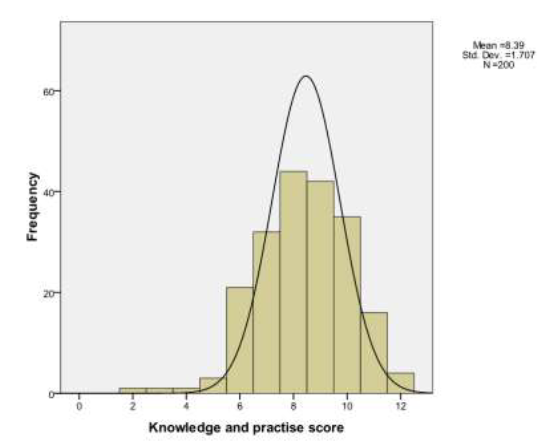
Figure 1: Distribution of participants’ knowledge and practice score.
The knowledge score was categorized as follows: A score of above 75% was labelled as good, above 60-75% as fair, and less than 60% was marked as poor. According to this criterion, 55(27.5%) participants had good general knowledge about the subject under study,139(69.5%) had fair knowledge while 6(3%) demonstrated a lack of awareness regarding the hazards of ultraviolet radiation. (Figure 2).
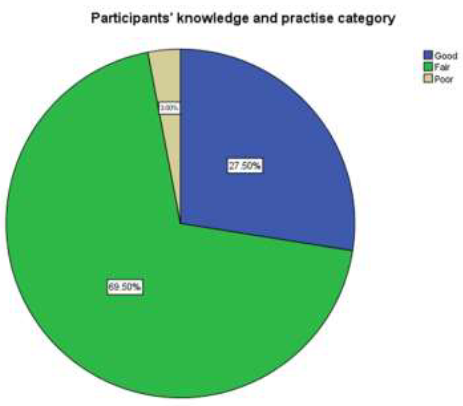
Figure 2: Distribution of participants’ knowledge and practice category.
Using umbrella was cited as the preferred method of protection against the effects of the sun by 57.2% of the females and males usage of hats was the most popular method as cited by 14.5%. (Figure 3).
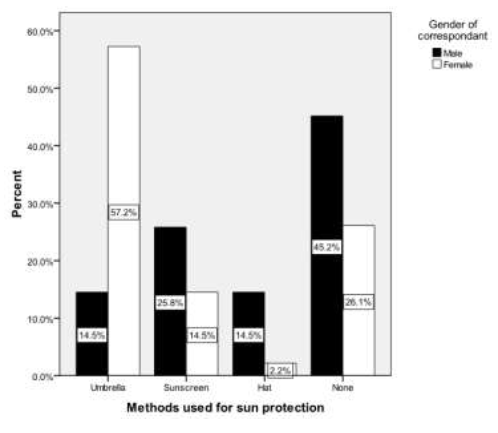
Figure 3: Comparison of preferred methods for sun protection among males and females.
48% of the students attributed their motivation for avoiding the sun to health implications and 44% avoid the sun for cosmetic enhancement. (Figure 4).
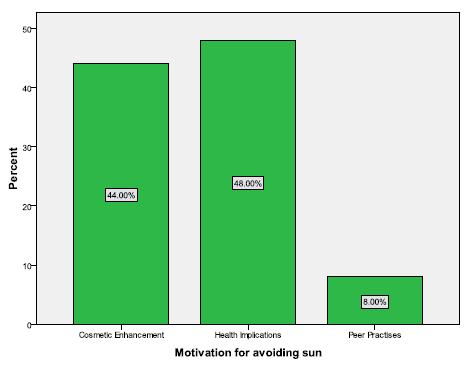
Figure 4: Participants’ motivation for sun avoidance.
Regarding awareness, 35.5% of the participants reported never having received education about the hazards of ultraviolet radiation. (Figure 5).
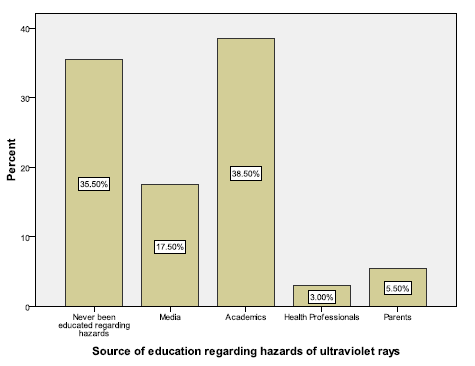
Figure 5: Distribution of sources of education regarding the hazards of ultraviolet radiation.
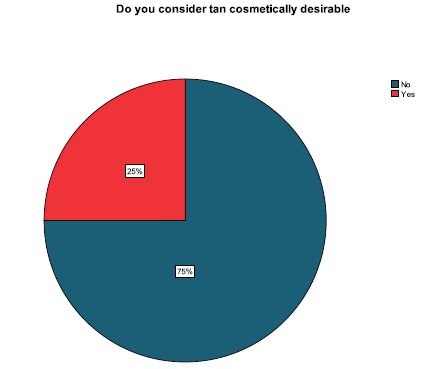
Figure 6: Response of students when asked if they considered a tan cosmetically desirable.
4. Discussion
Excessive exposure to ultraviolet radiation has detrimental effects on the health of an individual. UV emitting devices have been classified as Group 1 “carcinogenic to humans” [4]. Cumulative effects include damage to the skin (actinic keratosis) and malignant tumours of the skin [20]. The incidence of melanoma is especially high among Austrians and Caucasians and the rate is still rising despite 80% of the carcinomas being preventable with the use of effective sun protection methods [11].
This current study was carried out to determine the knowledge and practices of medical students regarding the hazards of ultraviolet radiation. Not much is known about public awareness regarding the topic under study among Pakistani people as extensive research has not been carried out previously in the country.
In a study conducted in Turkey, low skin cancer knowledge was demonstrated among university students [11]. And in UAE, Alawad et al 2017 also found out poor knowledge and practices among students towards sun protection with only 8.1% of the correspondents having good knowledge [18]. Contrary to these, our study revealed good general awareness with mean KAP score being 8.39±1.71 with 27.5% having good knowledge and practice.
Previous studies had concluded that women were more likely to be aware of the untoward effects of ultraviolet radiation as compared to men [11, 13, 20]. And that participants’ awareness level had a direct relationship with parental education level(p=0.008) [18]. This contrasted with our results which revealed no statistically significant difference between knowledge and practice scores of men and women and no effect of parents’ education level on knowledge and practice scores of participants. Our study also revealed no statistical association between the age of participants and their awareness level (Alawand et al 2017 had similar results) [18]. Students with wheatish complexion showed better knowledge than participants with fair or dark skin tones(p<0.05).
The most widely recognized effect of ultraviolet radiation was that it causes ageing, wrinkling, and discolouration of the skin with 91.5% of the students giving the correct answer. Almost similar results were found by Eray et al (2012) in which 89.8% of the students cited it correctly [12]. 167 of the 200 students knew that light-coloured clothing compared to dark-coloured clothing offers better protection against the sun as shown in our study.
Ultraviolet radiation also suppresses the immune system of our body [21]. But this was one of the least known effects of ultraviolet radiation among participants with only 28.5% citing it correctly. Our finding was similar to the study by Eray et al (2012) with their result being 16.4% [12]. Another least known effect was “sunburn can occur on a cloudy day” and only 45 of the 200 participants gave the correct answer.
Regarding sources of information, 17.5% reported having received education from media as opposed to western studies in which television and the internet were the most common sources [11, 12]. Health professionals and parents were the least common sources of information (3% and 5.5% respectively) which illustrates the potential need for the promotion of sun-related practices through counselling of parents by health professionals so that parents can encourage good sun-safe habits among their children at an early age. 38.5% of the students knew about the hazards of ultraviolet radiation by virtue of their academics which is expected from medical students who have higher knowledge about health-related matters as opposed to the general population.
According to our study, it was found out that having a tan is not considered cosmetically desirable supported by the results in which 75% agreed that they did not find a tan appealing. On the other hand, in western communities, tan is considered a sign of health and beauty and therefore acts as a motivating force for sunbathing and usage of tanning beds [14]. This was not the case in our study in which 44% of the participants reported avoiding the sun to prevent their skin from tanning. 48% avoided the sun due to health implications while the sun protection behavior of only 8% was influenced by peer practices as opposed to western studies in which media, family, and peer practices strongly influenced attitudes [14].
The most widely used method for protection by our female students was the use of an umbrella with 57% of the females using it and among males, it was the usage of hats and protective clothing (14.5%). Sunscreen usage was low among both males (25.8%) and females (14.5%) Al Ghamdi et al had similar results [13]. An alarming number of males (45.2%) used no active sun protection measure, which demonstrates the fact that good knowledge does not translate into good practice and there is an urgent need to bridge the gap between knowledge and practice.
5. Conclusion
In Pakistan, the research indicates, medical students demonstrated good knowledge regarding the hazards of ultraviolet radiation. Although the results suggest an encouraging number of people taking measures according to their convenience to avoid the harmful radiation, there was however a lack of adopting protective practices; this demonstrates that there exists a contradictory difference between the prevalence of essential knowledge about hazards of the UV radiation and adopted practices to protect against them. It could be due to multiple factors that should be explored further to ensure the implementation of relevant guidelines in the daily lives of the educated masses. The gap can be overcome by educational and awareness programs at all levels to eliminate the knowledge deficiency wherever it exists by encouraging a casual understanding of the health and cosmetic implications of UV radiation. In Pakistan, some other issues that can be tackled include a lack of wide availability of affordable sunscreens and awareness about good alternatives for skin protection against the UV. Some individuals, as the study explores, also resort to using other more convenient protective measures instead e.g. using umbrellas, wearing hats, etc which should be made widely available especially in the scorching summer sun. Reducing exposure in various other ways such as scheduling essential and non-essential outdoor activities at safer times can prove beneficial. The research results highlight the importance of the use of mass media to spread awareness to normalize and merge the adoption of protective measures in the daily lives of people as a common practice.
Funding Source
No external funding.
Author Contributions
Conceptualization: SS, FLS, NSS.
Data curation: SS, FLS, AI, NSS, MA, HA, HLS, NA, MUR.
Formal analysis: SS, FLS, NSS, AI, HA.
Funding acquisition: -
Methodology: SS, FLS, NSS, HLS.
Project administration: SS, MUR.
Visualization: SS.
Writing - original draft: SS, FLS, NSS.
Writing - review and editing: SS, FLS, AI, NSS, MA, HA, HLS, NA, MUR.
References
- Wilson D, Moon S, Armstrong F.Comprehensive review of ultraviolet radiation and current status on sunscreens. Journal of Clinical and Aesthetic Dermatology 5 (2012): 9.
- Geller AC, Rutsch L, Kenausis K.Can an hour or two of sun protection education keep the sunburn away? Evaluation of the Environmental Protection Agency’s Sunwise School Program. Environ. Health 2 (2003): 1-13.
- Haluza D, Simic S, Moshammer H.Sunbed Use Prevalence and Associated Skin Health Habits: Results of a Representative, Population-Based Survey among Austrian Residents. Int. J. Environ. Res. Public Health 13 (2016): 231.
- K Woo D, J Eide M.Tanning beds, skin cancer, and vitamin D: An Examination of the. Scientific Evidence and Public Health Implications. Dermatology Therapy 23 (2010): 71.
- John D’OrazioJ, Jarrett S, Amaro-Ortiz A, et al. UV Radiation and the Skin. Int. J. Mol. Sci 14 (2013): 12222-12248.
- Wright Cy, Norval M, Summers B, et al. The impact of solar ultraviolet radiation on human health in sub-Saharan Africa. S Afr J Sci 108 (2012).
- Behar-Cohen et al.Ultraviolet damage to eye revisited: eye-sun protection factor (E-SPF), a new ultraviolet protection label for eyewear. Clinical Opthamology 8 (2014): 87-104.
- Beach N.Understanding and Influencing Adolescent Attitudes Beliefs and Behavior Regarding UVR Exposure (2006).
- Robinson JK.Sun exposure, sun protection, and vitamin D. JAMA 294 (2005): 1541-1543.
- Parkin DM, Mesher D, Sasieni P.Cancers attributable to solar (ultraviolet) radiation exposure in the UK in 2010. Br J Cancer 105 (2011): 66-69
- Ugrlu Z, Isik SA, Balanuye B, et al.Awareness of Skin Cancer, Prevention, and Early Detection among Turkish University Students. Asia-Pacific Journal of Oncology Nursing 3 (2016): 93-97.
- Yurtseven E, Ulus T, Vehid S, et al.Assessment of Knowledge, Behaviour and Sun Protection Practices among Health Services Vocational School Students. Int. J. Environ. Res. Public Health 9 (2012): 2378-2385.
- Khalid M, Aeed S, AlAklabi, et al.Knowledge, attitudes and practises of the general public towards sub exposure and protection: A national survey in. Saudi Arabia. Saudi Pharmaceutical Journal 24 (2016): 652-657.
- Kirk L, Greenfiel S.Knowlege and attitudes of UK university students in relation to UVR exposure and their sun related behaviours: a qualitative study. BMJ Open 7 (2017): 3.
- MoshammerH, et al. UV-Radiation. From Physics to Impacts.Int. J. Environ. Res. Public Health 14 (2017): 200.
- TerziS, et al. Evaluation of knowledge, attitude, and behavior about harmful effects of the sun and sun protection among patients attending an outpatient clinic.Turkderm-Turk. Arch Dermatol Venereology 51 (2017): 2-7.
- Yurtseven E, Ulus T, Vehid S, et al.Assessment of Knowledge, Behaviour and Sun Protection Practices among Health Services Vocational School Students. Int. J. Environ. Res. Public Health 9 (2012): 2378-2385.
- Alawad A, Alyassin H, Alrefai A, et al. Assesment of sun health awareness levels among medical sciences female students at Ajman University. Ejpmr 4 (2017): 623-628.
- Zuba E, et al.Knowledge about Ultraviolet Radiation Hazards and Tanning Behavior of Cosmetology and Medical Students. Acta Dermatoveneral Croat 24 (2016): 73-77.
- Skonieczna J, et al.Assessment of knowledge about the effects of UV radiation on health and health behaviors associated with sunbathing in gymnasium students. Prezgel Epidemiol (2016): 65-72
- Schwarzt T.Mechanism of UV-induced immunosuppression. Kieo J Med 54 (2005): 165-167.
